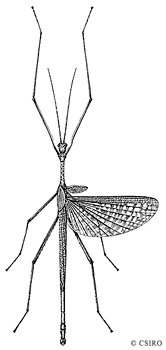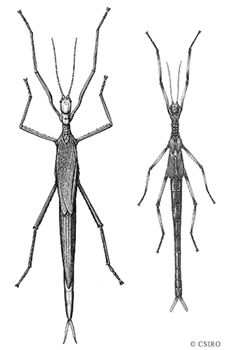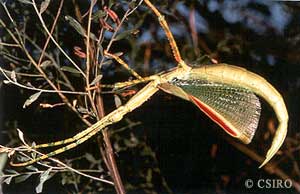|
Phasmatodea:
stick and leaf insects
Characteristics
As their
name suggests these cryptic insects have the shape and colouring
of the leaves and twigs of the plants they inhabit. Phasmids are
distinctive insects and are often large to very large ranging in
size from 30 to 300 millimetres in body length. Stick and leaf insects,
when discovered will often drop to the ground and remain motionless
rather than take flight. Some species will also shed legs when attacked,
growing them back over time. Phasmids are distinguishable by the
following features:

Ctenomorphodes
tessulatus
(PHASMATINAE)
|
|
- Body shape
variable but most are elongate and cylindrical or flattened and
resemble sticks, leaves or grass
- 2 pairs of
wings although some species are wingless
- Wings when
present consist of short, hardened forewings which form a protective
cover over part of the larger membranous
hind wings
- Antennae
are filiform
and may be either short or long
Phasmid nymphs
usually resemble adults but lack wings.
PHASMATINAE
are a prominent subfamily of phasmids with an Australia-wide distribution.
Most species are large, fully winged and stick-like in appearance.
Ctenomorphodes tessulatus is a medium sized stick insect
which has a spiny mesonotum
and a mosaic patterned hind wing. The males of this species are
fully winged and the females either short-winged or flightless.
Life Cycle
Male phasmids
are generally smaller than the females and have more functional
wings. It is usually the males that will fly around to locate a
mate. Female phasmids usually lay their eggs in leaf litter and
can lay between 100 and 1000 depending on the species. The eggs
may hatch in the same season they were laid or remain in the litter
to hatch up to 3 seasons later depending on the conditions. Nymphs
moult
several times before reaching maturity and development may take
from a few weeks up to a few months.
Feeding
All phasmids are herbivores
as both adults and nymphs
feeding on the leaves of trees and shrubs, although a few species
are known to eat grasses. Nymphs
favour the younger softer leaves at the tips of branches while adults
are able to feed on both young and old leaves. Some populations
of stick insect species can grow to such large numbers that they
become pests, defoliating entire stands of trees with their voracious
appetites.
|

Podacanthus
wilkinsoni
(adult and last instar nymph)
|
This species
of phasmid has long cerci
and fully winged females and can grow up to 25 centimetres in length.
Podacanthus wilkinsoni known commonly as the ringbarker phasmid
can be distinguished from other stick insects by the orange-yellow
patch on the hind wing. This species is known to be a pest of eucalyptus
forests as it occasionally occurs in large numbers causing severe
defoliation of eucalyptus trees. In heavily infested areas this
species has even been known to eat the bark of trees.
Habitat
Stick insects are found over much of Australia where adequate trees
and shrubs occur to feed on. Those species known strictly as leaf
insects are only found in northern Queensland.
Eurycnema
goliath is a conspicuous, heavily built species known as the
Goliath stick insect and can be found over much of northern Australia
and down the east coast as far as Victoria. Females of this species
are fully winged and known to grow up to 25 centimetres in length.
|

Eurycnema goliath (Goliath stick insect)
|
|



